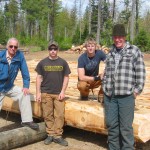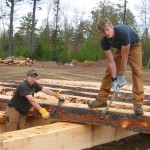Student Stories
Algonquin Forestry Students Help Build Timber Raft

In the 19th century, with few roads and no rail lines, logs were commonly floated down rivers to be sold to mills or shipyards. An old European technique of joining logs together was adapted in North America as a much more efficient way of getting the wood to market in countries of large proportions.
The loggers first squared the timbers, then slashed the logs together into a large raft. The rafts were then tied together and floated down a river to its final destination. In 1806, one of the first such raft trips in Canada took place near Ottawa, Ontario, by the family of settler Philomen Wright. That first trip did much to open up the logging industry in the Ottawa Valley and beyond. By 1908, with rivers being dammed, and railway lines and logging roads being built, the river highways became unnecessary.

A century later in Pembroke, Ontario, this logging tradition was honoured through the building a replica of a squared timber raft in the old ways of past loggers. Shaw Lumber donated the wood and some of the labour, with local forester and traditionalist woodsman Tom Stephenson taking the lead on the building the raft. Two Algonquin College Forestry Technician students, Trevor Slack and Isaac McEachern, helped with the labour-intensive job of stripping the bark and squaring the large white pine timbers—all with old-fashioned hand tools. See a video of raft trip highlights.
Pointer Boat: Unique Design for Old-Time Logging Operations
From the 1850s onward, a special boat for river log drives was used in the Ottawa Valley for over 100 years.
The “pointer boat” was specially designed by John Cockburn of Ottawa for lumber baron J.R. Booth, one of the most influential men in Canada’s logging era. Cockburn moved his boat building business to Pembroke, and with his sons, built 200 pointer boats a year. The unique design of the boat, which resembles a maritime fishing dory but draws very little water, has an identical bow and stern. With the ability to move easily in either direction, the design meant that the men in the boats could concentrate on moving the huge logs down the river, prying, pushing and clearing them with pike poles and brute strength, without having to maneuver the boat around.
As part of the city’s 150th anniversary, a replica pointer boat was built by a group of high school students in Pembroke. Fellowes High School students fashioned the craft from old designs and the finished product weighed close to a ton. In addition to a journey down the Ottawa River from Petawawa to Pembroke, the boat was on display during Pembroke’s Waterfront Festival celebrations, and available for many local residents and visitors to enjoy a demonstration ride.
After the pointer boat’s last ride, it became part of a special logging exhibit at Pembroke’s waterfront area. Just over 20 Forestry Technician students and their professor carried the huge boat down walkways, over grassy areas, and up onto the crib where they positioned it for display. The overhead shelter was built ‘shanty style’, and will eventually house some other old-time logging era artifacts.